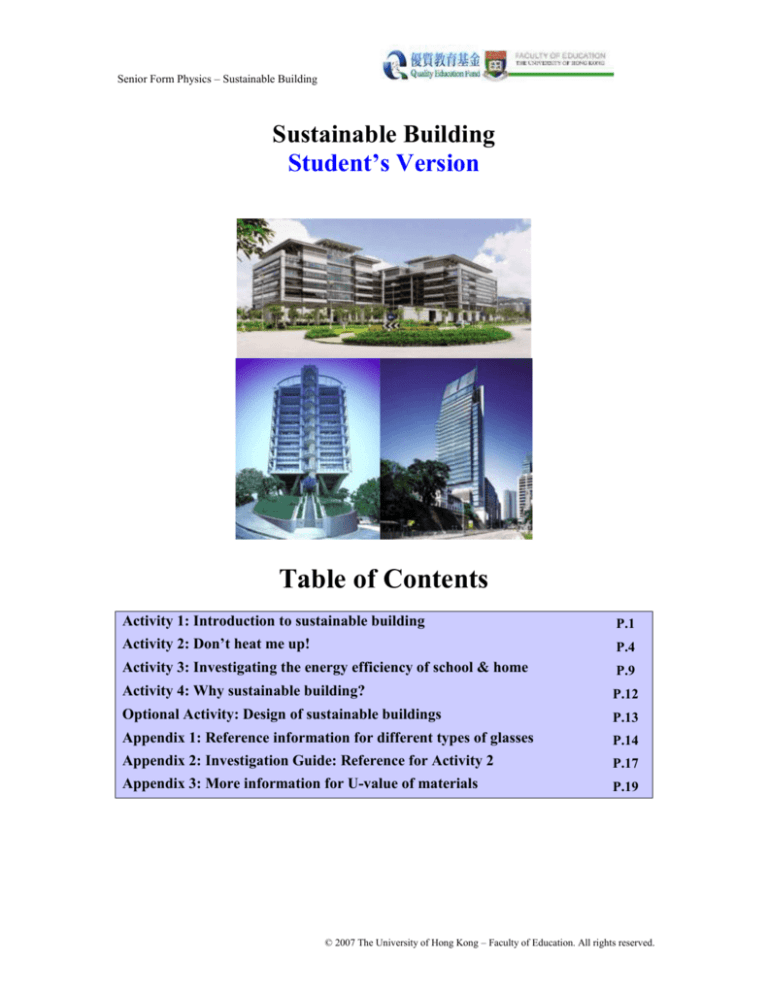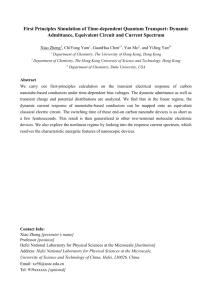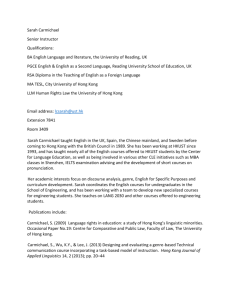
Senior Form Physics – Sustainable Building
Sustainable Building
Student’s Version
Table of Contents
Activity 1: Introduction to sustainable building
P.1
Activity 2: Don’t heat me up!
P.4
Activity 3: Investigating the energy efficiency of school & home
P.9
Activity 4: Why sustainable building?
P.12
Optional Activity: Design of sustainable buildings
P.13
Appendix 1: Reference information for different types of glasses
P.14
Appendix 2: Investigation Guide: Reference for Activity 2
P.17
Appendix 3: More information for U-value of materials
P.19
© 2007 The University of Hong Kong – Faculty of Education. All rights reserved.
Senior Form Physics – Sustainable Building
Activity 1
Introduction to sustainable building
“Sustainable development is development that meets the
needs of the present without compromising the ability of
future generations to meet their own needs.”
The term “Sustainable Building” comes from “Sustainable
Development”. In 1987, the Prime Minister of Norway, Dr.
Gro Harlem Brundtland created the landmark definition of
Sustainable Development in the Brundtland Report, “Our
Common Future”
Q1.
Brainstorm some essential features of a sustainable building based on the landmark
definition of “Sustainable Development” above, and what you may have learned through
other aspects of environmental education.
P. 1
© 2007 The University of Hong Kong – Faculty of Education. All rights reserved.
Senior Form Physics – Sustainable Building
Q.2
What are the different types of energy use in residential buildings and in commercial
buildings in Hong Kong?
Among the uses of energy you mentioned, which consumes the largest amount of energy?
You will look into it in Activity 2 – “Don’t heat me up!”
P. 2
© 2007 The University of Hong Kong – Faculty of Education. All rights reserved.
Senior Form Physics – Sustainable Building
Q.3
The technology of air conditioning gives us a more comfortable environment during
summer but it also brings us some negative impacts. Can you list some?
P. 3
© 2007 The University of Hong Kong – Faculty of Education. All rights reserved.
Senior Form Physics – Sustainable Building
Activity 2
Don’t heat me up!
Engineers have to make sure buildings are comfortable to
live in – not too hot in summer and not too cold in winter.
To achieve this aim they use different kinds of building
materials to reduce the heat transfer through conduction
and radiation.
Quick revision: How is heat transferred? By which three processes?
Investigation: To find out whether single glass or double-glazed glass can better slow
down the heat gain of indoor space by sunlight. Draw your design in the space below:
P. 4
© 2007 The University of Hong Kong – Faculty of Education. All rights reserved.
Senior Form Physics – Sustainable Building
First round of hot box test (Single glass VS Double-glazed glass)
A
B
A - Double-glazed glass [20 mm thick]
B - Single glass [20 mm thick]
Setup (Data logger with temperature sensors)
Temperature (oC) at 30-second intervals
Time (seconds)
Double-glazed glass
Single glass
0
30
60
90
120
150
180
210
240
270
Q. What is the result of the demonstration? How can you explain the result?
P. 5
© 2007 The University of Hong Kong – Faculty of Education. All rights reserved.
300
Senior Form Physics – Sustainable Building
Second round of hot box test
(Glass with sun control film VS Low-e glass VS Clear glass)
A
B
C
A - Low-emission / Low-e glass [6 mm thick]
(coated with metallic oxide reflecting layer)
B - Glass coated with “3M” radiant energy blocking film (sun control film) [6 mm thick]
(solar films are used to reduce the heat gain of a building through radiation)
C - Clear glass [6 mm thick]
(ordinary glass with poor heat insulation properties)
Setup (Data logger with temperature sensors)
Temperature (oC) at 30-second intervals
Time (seconds)
Low-emission glass
Glass with sun control film
Clear glass
0
30
60
90
120
150
180
210
240
270
Q. What properties of the sun control film and low-emission glass may account for the
experimental results?
P. 6
© 2007 The University of Hong Kong – Faculty of Education. All rights reserved.
300
Senior Form Physics – Sustainable Building
Third round of hot box test
A
B
C
A - Ceramic tile [6 mm thick]
(common on walls of kitchens, bathrooms and exterior surfaces)
B - High-density polystyrene board [6 mm thick]
(a kind of very high density foam, a common component of roof structure)
C - Wooden board [6 mm thick]
(used as building materials in countries overseas)
Setup (Data logger with temperature sensors)
d
Temperature (oC) at 30-second intervals
Time (seconds)
Polystyrene board
Ceramic tile
Wooden board
0
30
60
90
120
150
180
210
240
270
300
Q. What is the result of the demonstration? How can you explain the result?
P. 7
© 2007 The University of Hong Kong – Faculty of Education. All rights reserved.
Senior Form Physics – Sustainable Building
Further discussions
The hot box test (with a much more complex setup) is commonly used in buildings
research. Discuss the importance of the hot box test to the design of sustainable buildings.
U-value and shading coefficient are two common measurements in comparing the
thermal properties of materials in industry:
U-value is a measure of heat transmission due to thermal conductivity (conduction +
radiation + convection) of a material. The lower the U-value, the less heat is transmitted
through the material.
(Refer to appendix 3 for more detailed information for U-value of materials)
Shading coefficient is the ratio of solar heat gain through a piece of special glass to the
solar heat gain through a single piece of 3mm thick clear glass under the same set of
conditions. The smaller the number, the better the special glass at stopping the entry of
solar heat radiation.
Rank the materials tested in second round by their shading coefficients.
Other special building materials: Fire-resistant glass
There are many types of specially made building materials and glasses serving for
different needs of buildings. Fire-resistant glass: a kind of glass that is widely used in
buildings for safety purpose. Can you think of some features of this type of glass that can
enable it to have “fire-resistant” property?
P. 8
© 2007 The University of Hong Kong – Faculty of Education. All rights reserved.
Senior Form Physics – Sustainable Building
Activity 3
Investigating the energy efficiency of your school
building and home building
The use of carefully selected building materials is only one of the many ways to improve
the energy efficiency of buildings. We will explore some other ways in this activity.
Let’s first go back in time to learn about the most ancient sustainable “building“
before investigating the modern buildings around you.
Before building technology began, people used to live in caves – the most ancient sustainable
“building”. Cave dwelling (穴居), as shown in the pictures below, provided prehistoric people
with a “comfortable” and “safe” home.
What are the advantages of cave-dwelling?
In China, cave dwellings are mostly found in the North and located on mountains. Why?
P. 9
© 2007 The University of Hong Kong – Faculty of Education. All rights reserved.
Senior Form Physics – Sustainable Building
Now come back to the modern age. Can you think of:
1) Designs of buildings that can help to improve energy conservation?
2) Ways that the occupants can help to increase energy conservation in modern buildings?
Design changes of buildings / Ways that occupants can help:
If you only have a few ideas, you are recommended to
download and read the Energy Efficiency and Conservation
for Buildings Guide from the website of Electrical and
Mechanical Services Department (EMSD)
URL: http://www.emsd.gov.hk/emsd/eng/pee/em.shtml
(Last visited on 30 – 05 – 2007)
This contains many suggestions for the builders (designs of the
buildings) and occupants (ways they can help) to reduce energy
use in a building.
P. 10
© 2007 The University of Hong Kong – Faculty of Education. All rights reserved.
Senior Form Physics – Sustainable Building
Action!
Part 1: Planning the investigation
Make a checklist based on the answers from the previous discussion with your
groupmates. The checklist should consist of a list of energy efficiency features of
buildings. Use it to investigate your school building and your home building. Evaluate
the energy efficiency of these two buildings based on the results of your investigation and
present the findings to your classmates.
Tips for investigation:
1. Take some photos of good or poor energy efficiency features of the building.
2. It is not easy to obtain first hand information about the designs of the buildings.
You may need to talk with the people who are familiar with the designs and
structures of the buildings. (E.g.: School staff, management committee or
maintenance staff of your home building…etc)
3. You can investigate any other building if you are confident that you can get more
information for the investigation, instead of your home building.
Part 2: Presenting your findings
You may organize your findings in a PowerPoint slide show and present it in front of
class. You could show some photos from the investigation. Sometimes it is very difficult
to compare the energy performance or energy saving features of different types of
buildings, you may focus on describing the features you observed during the
investigation instead of trying to do comparisons between different buildings. For your
school building, you might write a class report for the Principal, suggesting ways the
school could improve its energy sustainability.
Measurement is very important in science. For example the Air Pollution Index (API)
is a tool created to compare the air pollution level of the air in different locations. (URL:
http://www.epd-asg.gov.hk/english/api_you/whatapi.php ) When engineers perform an
“energy audit” of a building, some measurements are needed to measure the energy
performance of a building and compare different buildings’ energy performance. For
example, the OTTV (Overall Thermal Transfer Value) is an index for comparing the
thermal performance of buildings. It is a measure of the average heat gain into a building
through the walls and other surfaces and consists of three major components: (a)
conduction through opaque walls, (b) conduction through window glass, and (c) solar
radiation through window glass. The usual practice is to have two sets of OTTV: one for
the exterior walls and the other for the roof. You can read the website:
http://www.bd.gov.hk/english/documents/code/e_ottv.htm for more information about OTTV.
P. 11
© 2007 The University of Hong Kong – Faculty of Education. All rights reserved.
Senior Form Physics – Sustainable Building
Activity 4
Why sustainable building?
(Further discussions on STSE)
Apart from the technical aspects (such as testing of building materials), the topic of
sustainable building can lead to many useful discussions. Discuss the following questions
with your classmates and teachers. This may be related to future careers if you want to be
an architect, an engineer or a materials scientist for instance.
- Why do we need sustainable buildings?
- What are the benefits of sustainable buildings?
- Who are the beneficiaries?
- Can you illustrate the interactions between science, technology, society
and environment (STSE) with the context of sustainable building?
Discussion notes:
P. 12
© 2007 The University of Hong Kong – Faculty of Education. All rights reserved.
Senior Form Physics – Sustainable Building
Optional Activity
Appreciate the designs of some well known
sustainable buildings in Hong Kong and
globally
Dr. Sam Hui, a specialist in sustainable building, has found a data-base analysing some
well known sustainable buildings in Hong Kong and all over the world. You are
recommended to visit the following website for an interesting and deep exploration of
sustainable buildings to develop your study of this topic.
“Case Studies on Sustainable Buildings”
URL: http://www.hku.hk/mech/sbe/case_study/index/top.htm
(Last visited on 30 – 05 – 2007)
Activity for your interest: Read the information about the following four sustainable
Hong Kong buildings in the website and then have a close look at them when you have
time to visit them!
Hong Kong Science Park, Tai Po
One Peking Road TST
Hong Kong Museum of Coastal Defence, Shau Kei Wan
Kadoorie Biological Sciences Building,
The University of Hong Kong
P. 13
© 2007 The University of Hong Kong – Faculty of Education. All rights reserved.
Senior Form Physics – Sustainable Building
Appendix 1:
Comparison of different types of glazing (Source: EMSD)
Criteria for good glazing: low thermal conductivity and high visibility
Characteristic
特性
Properties
特質
Thermal transfer
value (W/m2℃)
熱傳送值
(瓦特/平方米度攝
氏)
Shading coefficient
遮陽系數
Sound Reduction
Index (dB)
隔音 (分貝)
Solar load
日光負載
Transmission load
透熱度
Glare pollution
室外炫光效果
Reflectance
反射系數
Visibility
透光度
P. 14
Double glazing
Single glazing
with coatings
with coatings
有塗層的雙層玻璃 有塗層的單層玻璃
Low emission
Single glazing
double glazing
without coating
低放射性的
沒有塗層的
雙層玻璃
單層玻璃
Two layers of
Only one layer of Invisible metallic Typical clear
glass separated
glass
coating admits
glass without
by a spacer
visible
light
but
any treatment or
單層玻璃
blocks
radiant
coating
雙層,中間留
heat
一般的透明玻
Coating provides
有空間
a reflective barrier 表層為看不見
璃,沒有經過
的金屬塗層,
Coating provides with choice of
任何處理或加
colours such as
a reflective
可透光亦能阻
上塗層
silver, bronze and
barrier with
隔輔射
choice of colours gold etc.
Only one layer
塗層具反射作
such as silver,
Two layers of
of glass with
bronze and gold 用,備有銀色、 glass separated
custom choice of
etc.
銅色、金色等多 by a spacer
colours or clear
塗層具反射作
種顏色可供選擇
雙層玻璃,中
單層玻璃,可
用,備有銀
間留有空間
以是透明,亦
色、銅色、金
可自選顏色
色等多種顏色
Clear or
laminated colours
可供選擇
透明或可塗上
顏色
2.4 – 3.29
4.88 – 5.96
1.6 – 1.87
5.22 – 6.76
0.4 – 0.89
0.23 – 0.47
0.12 – 0.45
0.73 – 0.89
Max. 33
最高值為 33
Max. 25
最高值為 25
Max. 32
最高值為 32
Max. 25
最高值為 25
Medium
中等
Medium
中等
Slightly High
稍高
Slightly High
稍高
Lowest
最低
Medium
中等
Highest
最高
Highest
最高
Highest
最高
Lowest
最低
Lowest
最低
Lowest
最低
Slightly Low
稍低
Slightly Low
稍低
Highest
最高
Highest
最高
Highest
最高
Lowest
最低
Lowest
最低
Highest
最高
© 2007 The University of Hong Kong – Faculty of Education. All rights reserved.
Senior Form Physics – Sustainable Building
Fire-resistant glass
There is a transparent interlayer (called the intumescent layer) between two sheets of
glass. It is the intumescents (materials in the interlayer) which give the fire-resistant
properties to the glass.
An intumescent is a substance which swells as a result of heat exposure, thus
increasing in volume, and decreasing in density. The chemical change is
endothermic (absorbs heat) since the intumescent contains chemically bound water.
Intumescents are very important in fire prevention and commonly used in fire protection
products. A crucial factor in passing fire tests for fire protection products is to keep the
item being protected below its critical temperature. For example, structural steel loses its
strength above 550°C. Steel first expands with increasing heat, but once above its critical
temperature, it weakens, like spaghetti in boiling water. (Remember the collapse of the
Twin Towers in New York on 11 September 2001 (9/11) after they were set on fire by
the plane crashes!)
Hydrates (chemically bound water) in the intumescent layer can keep their surroundings
at around 100°C, the boiling point for water, until all the hydrates are boiled off. In
fireproofing applications using intumescents with hydrates, the temperature increase in
the item to be protected, tends to "flatline" at the 100°C mark, until all the water is gone.
Then, the temperature begins to increase rapidly again.
Fire temperatures in a building can reach 1100°C depending on the fuel present and the
availability of oxygen. The presence of hydrates in intumescents can keep the item
exposed to the heat at or below 100 °C, until all the water boils away.
The intumescent layer of the fire-resistant glass we use in the test will change and expand
into a rigid, non-transparent shield at temperatures above 120oC. (Shown in picture below)
Such a shield will not let the glass break or melt at high temperature. No flame, smoke or
hot gases can pass through the shield. The shield also does not effectively transmit heat
since it is an insulator.
The picture above shows the appearance of the glass after
expansion of the intumescent interlayer at high temperature.
P. 15
© 2007 The University of Hong Kong – Faculty of Education. All rights reserved.
Senior Form Physics – Sustainable Building
The pictures below show how the appearance of a piece of fire-resistant glass changes
when it is heated by a Bunsen burner.
Before heating
After heating for 20 minutes
After heating for 40 minutes
After heating for 60 minutes
P. 16
© 2007 The University of Hong Kong – Faculty of Education. All rights reserved.
Senior Form Physics – Sustainable Building
Appendix 2: Investigation guide for the hot box test
Key steps and remarks for setting up the hot box test:
1. Attaching the building materials to the hot box by magic tape.
2. Installing the temperature sensor / mercury thermometer
Remark: Use the scale marked on the holder to make sure the distance between
temperature sensor and the building materials are the same on each side.
Scale marked on the holder
P. 17
© 2007 The University of Hong Kong – Faculty of Education. All rights reserved.
Senior Form Physics – Sustainable Building
3. Setting a distance of around several cm between the temperature sensor and the
test material.
4. Installing the light bulb.
5. Connecting the temperature sensors to data logger for data processing. (Done)
Remarks:
The bulb of the thermometer / tip of the sensor should be located at the centre of the
test material (approximately). The horizontal distance between the thermometer
bulb and the test material and the vertical distance between the thermometer bulb
and the table should be the same on each different face of the hot box test.
All the steps presented above are applicable to the measurements with
thermometers and data loggers. Please refer to your data logger menu for how to
record the real time temperature of the test materials, different models and types of
data logger have different software and procedures for presenting the data.
P. 18
© 2007 The University of Hong Kong – Faculty of Education. All rights reserved.
Senior Form Physics – Sustainable Building
Appendix 3: More information for U-value of materials
What is a U-value?
U-value is the measure of the rate of heat transfer through a material. Thus in all aspects
of home design one should strive for the lowest U-values possible because the lower the
U-value – the less heat that is needlessly escaping.
The calculation of U-values can be rather complex – they are measured as the
amount of heat lost (by conduction, convection and radiation) through one square
metre of the material for every degree difference in temperature on either side of
the material.
Units are Watts per metre squared per degree Kelvin or Wm-2K-1 (Wm-2 oC -1). So for
example, one square metre of a standard single glazed window will transmit about 5.6
watts of energy for each degree difference either side of the window or a U-value of 5.6.
A double glazed window will be significantly better than a single gazed window, with a
U-value of 2.8, i.e. only transmitting 2.8 watts of energy in similar conditions. i.e. they
are 100% more efficient in insulation.
Typical U-values
Note: These U-values are provided for reference only. U-values may vary depending on the
particular construction type.
1.Walls
Cavity Wall Insulation
*100mm Blown Polystyrene 0.30
100mm Blown Mineral Wool 0.30
100mm Blown Cellulose Fibre 0.30
60mm Extruded Polystyrene Insulation 0.40
35mm Polyurethane Foam Board 0.39
35mm Phenolic Foam Board 0.37
Timber Frame 150mm, Mineral Quilt 0.25
Timber Frame 140mm, Cellulose Fibre 0.19
Safewarm Home Construction 0.31
External Wall Insulation
60mm Moulded Polystyrene 0.44
2.Windows
Single Glazing 5.6
Double Glazing 2.8
Double Glazing, with Argon between layers 2.6
Double Glazing, Low-E 1.8
Double Glazing, Low-E with Argon 1.5
3.Others
150mm Glass Wool 0.25
150mm Rock Wool 0.23
150mm Sheep’s Wool 0.23
200mm Glass Wool 0.19
200mm Cellulose Fibre 0.16
Internal Wall Insulation
50mm Expanded Polystyrene 0.48
38mm Polyurethane 0.45
*“Blown” means with air filling spaces between the fibres, not compacted tightly”
Information provided by the Irish Energy Centre (funded by the Government of Ireland
under the National Development Plan with programmes part financed by the European
Union)
URL: www.irish-energy.ie
P. 19
© 2007 The University of Hong Kong – Faculty of Education. All rights reserved.








